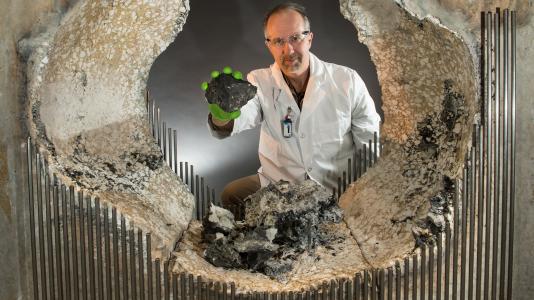Simulating core melt accidents helps improve nuclear reactor safety

Other Argonne scientists consulted for the DOE, lending their expertise in the very scenario that experts believed took place at Fukushima: nuclear fuel eroding the concrete floor beneath the reactor.
In all modern nuclear reactors, there are three barriers to contain the uranium fuel. The first is a layer of metal “cladding” directly around the uranium; the second is a thick steel reactor vessel; and the third is a sturdy concrete containment building with walls, floors, and ceiling several feet thick.
If a disaster, such as a tsunami, knocks out power to a reactor, all reactors have safety systems that shut down the reactor. However, the core continues to generate heat, and has to be continuously cooled. If backup generators fail and can’t cool the core—which is what happened at Fukushima—the uranium rods of the core and their cladding can melt together into a substance called “corium.” During a full meltdown, this material may leak through the steel vessel and pour out onto the thick concrete floor below.
To make sure that the final concrete barrier can withstand the stress of any failure at a reactor, Argonne nuclear engineers have been conducting tests for decades to simulate the effects of partial and full meltdowns on concrete materials.
Typically, researchers produce a large pool of molten corium via a chemical reaction and then run an electric current through it to mimic the heat produced in the fuel during a meltdown. Next, they examine how the corium interacts with the concrete beneath.
Argonne does the largest experiments of this type in the world, thanks to its early history as the U.S. Atomic Energy Commission’s primary lab for developing reactors for peaceful energy generation.
One of the lab’s most secure facilities lets a team of scientists safely conduct these experiments. The walls are three feet thick, built decades ago to contain experiments on fully functioning nuclear reactors; the air is heavily filtered and the thick steel doors seal shut. The building is now one of the only places in the national lab system rated strong enough to conduct these types of tests.
Nuclear energy companies often cosponsor the tests to improve safety at their plants. “We partner with both U.S. as well as international organizations in countries like France, Japan, and Korea,” said Argonne nuclear engineer Mitch Farmer, who leads the team. “We’re often testing unique cooling systems that can be placed in the concrete floors at plants in order to cool core material if it fails the reactor vessel, and this enhances reactor safety.”
Different types of concrete have unique chemical properties that can resist the corium, and can also affect how the corium erodes into concrete.
The experiments provide data for validating computer models that simulate corium-concrete interaction. These codes are widely used to support design improvements for nuclear reactors in safety and cost.
“This type of work is important because it both helps us understand what happened at Fukushima and how to minimize the impact of incidents in the future,” Farmer said.
This research was supported by the U.S. Nuclear Regulatory Commission, Électricité de France, and the Institut de Radioprotection et de Sûreté Nucléaire (French Institute for Radiological Protection and Nuclear Safety).
This article was published in the summer 2013 issue of Argonne Now, the laboratory science magazine.
DID YOU KNOW?
Almost every commercial reactor today is a light-water reactor.These reactors are cooled by water, which is cheap, easy to get, and well-understood. But many of the newest generation of reactor designs are “fast” reactors, which are interesting because they can burn recycled nuclear fuel. They are also designed to have passive safety mechanisms—if the power goes out, as at Fukushima, the reactor cools itself down without any electricity or human intervention.
